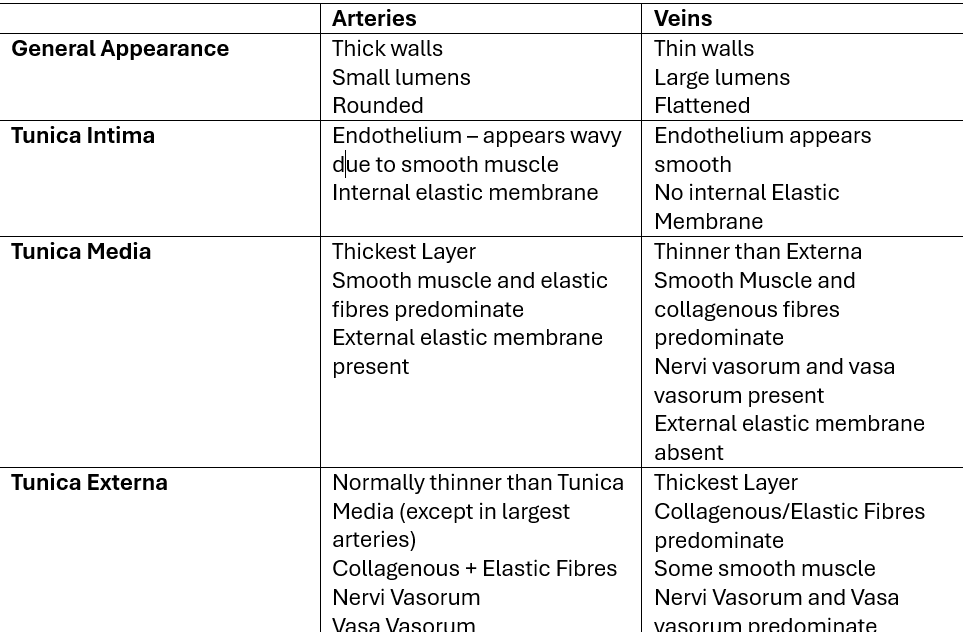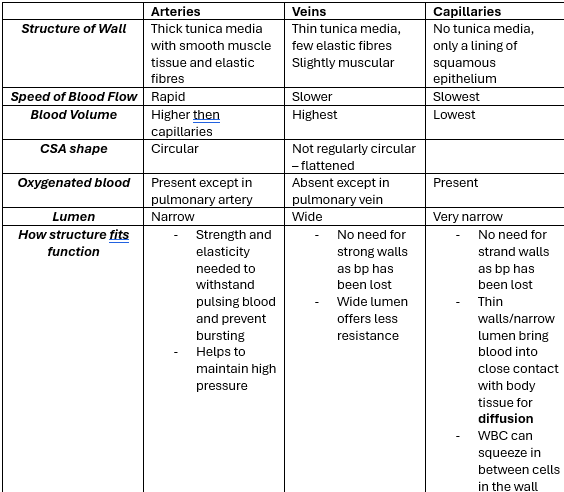Characteristics of Blood Vessels
1/22
There's no tags or description
Looks like no tags are added yet.
Name | Mastery | Learn | Test | Matching | Spaced |
|---|
No study sessions yet.
23 Terms
Blood Vessel System
artery → arterioles → capillaries
capillaries → venules → veins
Arteries and Arterioles
Heart pumps blood into major arteries
muscular arteries
microscopic arterioles
thicker walls then veins
arterial system is higher pressure - round and thick walls
more smooth muscle
more elastic tissue
allows them to dilate as blood pumps
Veins and Venules
microscopic venules
veins
venae cava
thinner and less elastic
because venous system is a lower pressure system
valves prevent backflow
appear flattened
Capillaries
microscopic vessels which branch out from arterioles
connect arteries to veins
made only of a tunica intima (Only endothelium)
in the lungs they absorb o2 and release co2
everywhere else capillaries absorb co2 and release o2
3 layer structure of vessels → arteries/oles veins/venules
tunica intima
tunica media
tunica externa
Tunica Intima
thin layer
squamous epithelium → endothelium
small amount of connective tissue
→ minimizes friction as blood is passing through lumen
Tunica Media
made of smooth involuntary muscle and elastic fibers
controls vasodilation and constriction
hence influences blood flow and pressure
this layer is thicker in arteries
Tunica Externa
layer of inelastic collagen fibres
connective tissue
anchors vessel to surrounding tissue
protects and reinforces blood vessels
Compare the Tunics in Arteries and Veins

Capillary is made only of endothelium why is this good
allows molecules to diffuse through
allows filtration through the pores between the cells
Arteries
larger arteries closed to the heart
thick artery walls
elastic middle layer → allows them to recoil/contract with blood flow (Smoother)
→ allow them to support high pressure
arteries further away have more smooth muscle
have neurons → regulate diameter of the artery
smaller arteries are less elastic but thick smooth muscle layer prevents them from bursting
Arterioles
endothelium wrapped with muscle fibres at intervals
where the arteriole and capillary meet there are pre-capillary sphincters
muscles which adjust blood flow
vasoconstriction (contraction of smooth muscle) → higher bp
vasodilation (relaxation of smooth muscle) → lower bp
Capillaries
so many capillaries and branching means that every cell is within 100 micrometers of a capillary
thin layer of cells- short diffusion distance
narrow lumen - rbc close to cells, shorter diffusion dist
membrane is permeable to water and dissolved substances
blood moving through capillaries slows down → more time for exchange of substances
loses pressure and velocity
Venules and Veins
same tissue layers as arteries but thinner smooth muscle layer
due to the fact they have a lower pressure
venule wall is made of inelastic and tough collagen fibres
greater lumen than artery
moves in one direction - venous valves
Varicose Veins
caused when the venous valves no longer work and blood pools in the veins
effect of skeletal muscle pump on venous blood flow
venous/muscle pump returns the blood back to the heart from the legs
skeletal muscle contracts - upper valve opens and blood moves upward while the lower valve closes (So contracting blood moves up)
muscles relax lower valve opens allowing veins to fill, upper valve closes preventing backflow
Comparison of Arteries, Veins and Capillaries

Pulsatile and Continuous Blood Flow
pulsatile flow; rhythmic, intermittent propagation of blood flow
found only in arteries
from great arteries to capillaries → flow becomes continuous
normal resting heart rate is 60-100bpm
Define Pressure
measure of the force that the blood exerts against the vessel wall as it moves through it
Blood Flow
volume of transported fluid per unit time and over a given arterial cross section
Blood Velocity
speed of a moving particle of blood
Velocity and Pressure in Arteries and Veins and Capillaries
The heart pumps blood at high pressure into the arteries.
Blood in arteries flows fast and under the highest pressure.
As blood moves from arteries → arterioles → capillaries → venules → veins, the pressure gradually decreases.
In capillaries, pressure and speed are lowest (to allow exchange).
From capillaries to veins, total cross-sectional area decreases, so velocity increases slightly again.
Vasoconstriction and Vasodilation
Vasoconstriction
contraction of smooth muscle
increase bp
maintain healthy blood flow
keep body temp from getting too cold
Vasodilation
relaxation of circular smooth muscle cells
decreased bp
increase blood volume when theres low o2 or low nutrients
also prevents increases in temperatrure
vasodilators are prescribed to those with hyper tension